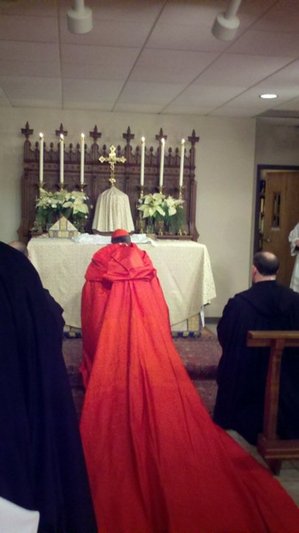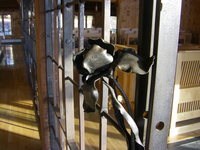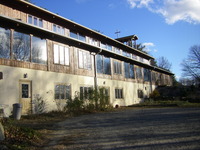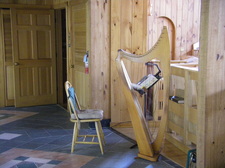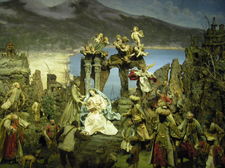The culture editor at America Magazine Jesuit Father James Martin, reviews the stunning movie “Of Gods and Men” on Religion and Ethics Newsweekly. His comments are worth hearing.
Tag: Benedictine
80 years of monastic profession: the witness of a lifetime
Permanent commitment is an awesome gesture. It is, however, becoming a thing of the past these days. I remember a few years ago
when my parents were celebrating their 40th wedding anniversary and one of my
mother’s clients said to her: “I can’t believe you’ve been married to the same
man for this long.” I was taken aback by the statement. In my mind what else would you do but be faithful to your vows. Of course this woman is on her second marriage and from all
reports pretty self-absorbed. There was a time when you entered into a “life
commitment” by vows and you did what they indicated: live them forever, unto death is there parting. Times have changed: prenuptials are “in” and convenience has replaced permanency. Have we become too fickle? Just
recently an event in Rome gave me hope: Father Angelo’s 80 years as a Trappist
monk of the Abbey of Tre Fontane. Imagine 80 years do anything! Imagine living your monastic profession in the place where Saint Paul was martyred! Saint Paul’s head bounced three times. Hence three fountains of water sprung up.
history), just celebrated his 94th birthday on March 3. Bishop Paolo
Schiavon, a long-time friend of the community offered Mass for Father Angelo’s
intentions.
priesthood, time as chaplain for the Trappistine nuns at Vitorchiano, his election
as abbot of Tre Fontane and his ten years in that capacity. All of Father
Angelo’s life can be seen as a homage, a testament to grace and grace’s living through his deep humanity known through fraternal
charity, humility and faithfulness to God’s call.
Lord does not count the number of one’s years, but weighs their quality” and “A
man is never taller than when he is on his knees before his Lord.”
Benedictine nuns & monks in Japan
The Benedictine news service provided the following news piece on the recent problems in Japan. We should pray to the Japanese martyrs for their assistance before the Throne of Grace:
Father Don
Talafous OSB, in one of his Daily Reflections, speaks about how
difficult it is to comprehend the enormity of the multiple disasters that have
befallen the people of Japan. Communications are still sparse from the
afflicted Diocese of Sendai, with 11,000 Catholics, that
includes the areas hardest-hit in the disaster. Several monks of Trinity Benedictine
Monastery, Fujimi, Japan, shared reports with the monks of Saint John’s
Abbey, the founding community. The
reports mention little damage at Fujimi, some disruption at the
Trappistine monastery, Nasu, Tochigi Prefecture, and the death of a
Redemptorist priest whose car was swept away.
Oscars 2011 and a nun
 Not surprising that many people are interested in sensational stories like “Mother Dolores Hart: The Nun Who Kissed Elvis Presley.” I guess kissing Elvis is akin to winning the jackpot. Each to his or her own! Thom Geier’s story is exactly titled such on EW.com. I have to admit, however, I am fascinated –to a degree– by this woman’s gesture of following a vocation that had in mind her eternal destiny and not just money, fame and power. Hart’s life and enduring witness to Christ at the Abbey of Regina Laudis, Bethlehem, CT, is inspiring. Who wouldn’t be inspired by a beautiful woman giving her life to God through monastic consecration!
Not surprising that many people are interested in sensational stories like “Mother Dolores Hart: The Nun Who Kissed Elvis Presley.” I guess kissing Elvis is akin to winning the jackpot. Each to his or her own! Thom Geier’s story is exactly titled such on EW.com. I have to admit, however, I am fascinated –to a degree– by this woman’s gesture of following a vocation that had in mind her eternal destiny and not just money, fame and power. Hart’s life and enduring witness to Christ at the Abbey of Regina Laudis, Bethlehem, CT, is inspiring. Who wouldn’t be inspired by a beautiful woman giving her life to God through monastic consecration!
Catholic nun, Mother Dolores has had many jobs: choir member, baker, and coffin
maker. She’s served as prioress, the convent’s second in command, for nine
years. But for the past two decades, she has spent a good deal of time each
winter on another assignment that harks back to her earlier, pre-monastic life:
Oscar voter.”
Cardinal Raymond Leo Burke visits the St Louis Oratory of Sts Gregory & Augustine
Benedictine monks create first handwritten Bible in 500 years
 Since the beginning of Benedictine monasticism monks and nuns have written original works of art that were used in the monastery library or assisting the praying community. Some of the monks and nuns copied existing manuscripts in order to have copies of a text in their own monastery or to send to other people. The Benedictine way of life creates new things and it preserves others. Kindles and iPads are somewhat foreign concepts in a culture that’s manual, personal and original. But modern means ought not be totally dismissed as incongruent to the old ways of doing things.
Since the beginning of Benedictine monasticism monks and nuns have written original works of art that were used in the monastery library or assisting the praying community. Some of the monks and nuns copied existing manuscripts in order to have copies of a text in their own monastery or to send to other people. The Benedictine way of life creates new things and it preserves others. Kindles and iPads are somewhat foreign concepts in a culture that’s manual, personal and original. But modern means ought not be totally dismissed as incongruent to the old ways of doing things.
The monks of Saint John’s Abbey and University have commissioned the Saint John’s Bible, the first handwritten, Illuminated Bible, the first work of this type in 500 years, that is, since the advent of the printing press. Certainly, the monks are leaving their mark on Catholic culture in the US for centuries to come. The artists commenced in 1998 with the idea of igniting the theological, liturgical and spiritual imagination of all people. The Saint John’s Bible illuminates the Word of God for the 21st century.
The dimensions of Saint John’s Bible is a manuscript that stands 2 feet tall and 3 feet wide when open. The head calligrapher is Donald Jackson, the calligrapher to Queen Elizabeth II. Jackson proposed the idea to Benedictine Father Eric Hollas who then waited three months before proposing the idea to Abbot John and the monks of Saint John’s. It’s written on vellum, using quills, natural hand-made inks, hand-ground pigments and gold leaf while incorporating various 21st century themes, images and technology. Artwork includes images of the World Trade Center towers, ashen skulls recalling the Cambodian killing fields, flora and fauna of Minnesota
On April 24, 2008, Pope Benedict XVI received the Books of Wisdom literature of the Saint John Bible and said it was “a work of art, a great work of art” and w “work for eternity.”
More info on the Bible project can be seen here.
Portions of the Saint John’s Bible is on display at The Church of Saint Paul the Apostle (9th Avenue & West 59th Street, NYC) until December 17.
Autumn days at the Abbey of Regina Laudis
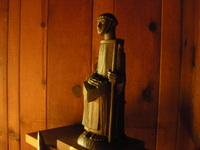 The Abbey of Regina Laudis is a special place in Connecticut; and one of the special Benedictine monasteries in the USA. I’ve been spending more time there in recent months either attending the Divine Office and/or Mass or spending a few days in St Joseph’s Guest House (for men, there are guests for women, married folks, & clergy).
The Abbey of Regina Laudis is a special place in Connecticut; and one of the special Benedictine monasteries in the USA. I’ve been spending more time there in recent months either attending the Divine Office and/or Mass or spending a few days in St Joseph’s Guest House (for men, there are guests for women, married folks, & clergy).

The Crèche at Regina Laudis: The Timeless story of a birth in Bethlehem …
If the crèche at
the Abbey of
Regina Laudis strikes you as a little out place, there’s a good
reason. The austere Yankee barn that houses it is a world away from its previous
home. Handcrafted by artisans in Naples, the intricate nativity scene was
presented as a coronation gift to Victor Amadeus II, king of Sardina, in 1720.
It remained among Italian nobility until it was purchased by Loretta Hines
Howard, an artist and collector, in 1949. She immediately donated it to what
was then a fledgling Benedictine Abbey in, fittingly, Bethlehem, Connecticut
(although the nuns insist the name is a coincidence).
The crèche takes a few
liberties with the traditional nativity story. Instead of a Judean village,
Bethlehem appears here somewhere on the coast of Italy. The stable has been
replaced by Corinthian columns, and the traditional kings and shepherds are
joined by a whole host of other characters, who have shed their New Testament
robes for 18th-century knickers and coats. In one corner, some
peasants argue over the contents of a stem pot. In another, a noblewoman walks
her whippet on a leash. The crowd is puzzling at first, though it may
serve a distinct purpose. “For as
many people as there are, there are attitudes toward the birth of Christ,” says
Sister Angèle Arbib, who helps care for the crèche. She points out some figures
who seems reverential, others who seem distracted or dis-believing: “It’s so
representative. When people come here to see the crèche, they identify with
someone in here.”
And people of all faiths do come to see it. The mass of
Christmas pilgrims has returned after a recent restoration had taken the crèche
out of public view for three years. Conservators from New York’s Metropolitan
Museum of Art painstakingly repaired each of the 68 figures and the tiny
hand-sewn outfits they wear. The results are stunning. The crèche now stands as
a testament to the continued support of the community of nuns,
preservationists, and believers that has formed around it. It’s fitting. After
all, what is a nativity other than a story of people coming together?
Shatwell
November/December, Vol. 74, No. 6.
Abbey of Regina Laudis
273 Flanders Road
Bethlehem, CT
The crèche is open to the public daily 10-4 through Jan. 5 (closed Jan. 6-Apr. 24)
203.266.7727
Abbot Timothy Kelly, OSB, RIP
 The monastic family of Saint John’s Abbey and the American Cassinese Congregation mourns the passing of Abbot Timothy Kelly who died on October 7. He was 76 and had been suffering from cancer.
The monastic family of Saint John’s Abbey and the American Cassinese Congregation mourns the passing of Abbot Timothy Kelly who died on October 7. He was 76 and had been suffering from cancer.
Sant’Anselmo: home to Benedictine monks, Rome
 For a number of years now, when I am in Rome, I stay at the Benedictine Abbey of Sant’Anselmo on the Aventine Hill. The Benedictine monks have been on the Aventine since property was purchased from Pope Leo XIII in the late 19th century. Technically, Sant’Anselmo is not a functioning abbey as other abbeys with a stable monastic community but it’s a house of studies for monks and others. There is an order for the day of prayer, Mass, study, and work but one does not become a monk of Sant’Anselmo as you would become a monk of Saint Vincent’s. At the Anselmo you’ll find a “permanent” faculty and staff, and a group of monks who work in the Abbot Primate’s offices and some monks who work at other universities or at the Vatican, but no monk vows stability to Sant’Anselmo.
For a number of years now, when I am in Rome, I stay at the Benedictine Abbey of Sant’Anselmo on the Aventine Hill. The Benedictine monks have been on the Aventine since property was purchased from Pope Leo XIII in the late 19th century. Technically, Sant’Anselmo is not a functioning abbey as other abbeys with a stable monastic community but it’s a house of studies for monks and others. There is an order for the day of prayer, Mass, study, and work but one does not become a monk of Sant’Anselmo as you would become a monk of Saint Vincent’s. At the Anselmo you’ll find a “permanent” faculty and staff, and a group of monks who work in the Abbot Primate’s offices and some monks who work at other universities or at the Vatican, but no monk vows stability to Sant’Anselmo.

